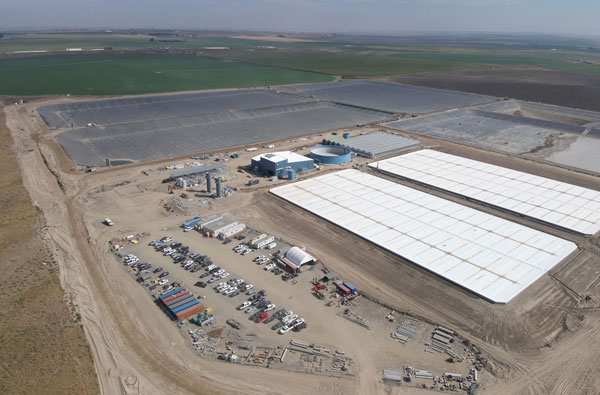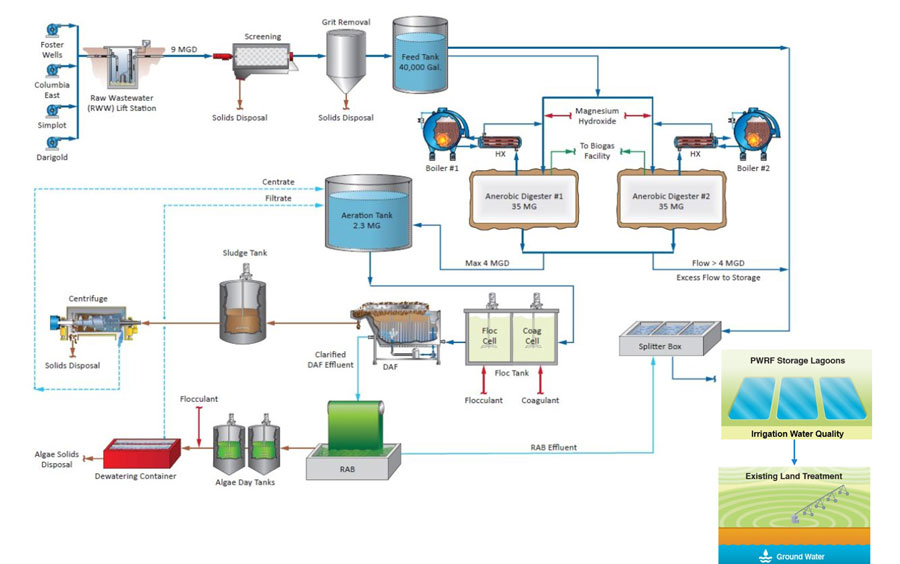By partnering to upgrade an outdated wastewater treatment plant, the City of Pasco is supercharging its local economy, and protecting its future.
By: Eric Wilinski
The story of agriculture in Pasco has always revolved around water. Located in the rain shadow of the Cascade Mountains, the city averages only seven inches of rainfall annually. But with the opening of the Grand Coulee Dam in 1941, acreage surrounding the city that had been fallow due to lack of water suddenly could sustain crops, and the region’s agriculture industry was born.
In recent decades, Pasco, a city of about 80,000 in southeast Washington, has made several significant investments to improve its management of wastewater from local food producers. Notably, in the 1990s Pasco built an industrial wastewater facility—the Process Water Reuse Facility—to pipe partially treated agricultural wastewater to city-owned farmland, where it sustains crops and, thanks to soil’s natural filtering effect, eventually becomes clean groundwater. This reduces the burden on the city’s municipal wastewater treatment plant and helps protect the water quality of the Columbia River.

An aerial view of the Pasco Resource Recovery Center (PRRC), currently under construction. (Photo courtesy City of Pasco)
However, more recently, the city recognized that its decades-old facility was no longer able to support local agricultural growth. Crucially, the aging plant was unable to treat increased wastewater volume or to remove nitrogen—a common ingredient in agricultural wastewater, which can contaminate groundwater—to the degree required by the state. The bottom line: doing nothing would inhibit the expansion of the food-processing industry.
To enable economic growth while protecting precious groundwater, in 2023, the city broke ground on the Pasco Resource Recovery Center (PRRC). The PRRC will treat an estimated 1.5 billion gallons of wastewater annually, removing nitrogen and other byproducts for reuse.
“Our old facility worked well, but after 30 years the infrastructure was exhausted,” says Maria Serra, Pasco’s public works director. “We wanted to upgrade to a next-generation facility, and to put the byproducts removed from wastewater to good use. Partnerships are helping us do that.”
To help execute the project, the city entered into a 30-year public-private partnership with Burnham RNG, a Virginia-based renewable natural gas (RNG) provider, to build, own, and operate the PRRC. The new facility will enable the capture and transformation of biogas into RNG, as well as utilize an innovative system from Gross Wen Technologies that uses algae to remove and capture nitrogen and phosphorus from wastewater.

A schematic diagram depicting how the PRRC will process raw wastewater. (Photo courtesy City of Pasco and Burnham RNG)
On the funding side, Pasco leveraged its relationships in Olympia and Washington D.C. to secure $5.05 million for the project in the Washington Legislature’s 2023-25 budget and to land a $4.4 million Congressionally Directed Spending allocation. The city also secured a $53 million funding commitment from the state’s Department of Ecology and a $5 million Community Economic Revitalization Board (CERB) low-interest loan. Funding also comes from Franklin County Economic Development grants and low-interest loans from state agencies.
Additionally, the city is entering a long-term deal to sell RNG to Cascade Natural Gas, generating millions of dollars per year to offset project costs. It also anticipates additional revenue streams from the sale of fertilizer and eventually from the sale of carbon credits (the algae used to capture wastewater nitrogen remove significant amounts of carbon from the atmosphere) and other reused byproducts of wastewater treatment.
“We’re excited to be building infrastructure capable of serving the next generation of growth in Pasco,” says Mayor Pete Serrano. “Partnerships let us take on big projects without taking on all the project risk. Without our partners, projects like this wouldn’t be possible for us.”
We’re excited to be building infrastructure capable of serving the next generation of growth in Pasco.
While the PRRC isn’t yet fully operational, it’s already bringing economic benefits to the city. Construction of the facility is pouring some $200 million into the local economy, and putting $85 million in workers’ pockets. And the facility’s expanded wastewater treatment capacity convinced Darigold, a dairy co-op, to move forward with the construction of a $600 million processing plant in Pasco.
Moving forward, the facility will support thousands of jobs at local food processors, produce enough RNG to serve 4,500 Washington state households annually, and have the capacity to serve a fast-growing agriculture sector.
These kinds of positive outcomes are made possible by the ongoing practice of identifying opportunities and cultivating partners. Explains Serrano, “Our staff and lobbyists work incredibly hard to find funding opportunities, build relationships, and communicate with partners.”
Perhaps for this reason, Pasco is in the middle of a public-works construction boom, with some $200 million in grants and low-interest loans supporting a range of current infrastructure projects, from new roadways to a new reservoir.
“Success breeds success,” concludes Serrano. “If you’ve shown you can deliver impactful projects on time and budget, partners are more likely to want to work with you on future projects.”